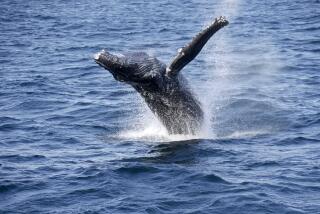Navy Seeks Options Amid Sonar Dispute
SAN DIEGO — The Navy will use passive sonar starting today during a major training exercise off Hawaii while exploring possible legal options to overcome a judge’s temporary ban on active sonar, officials said Tuesday.
Environmentalists with the Natural Resources Defense Council had brought suit alleging that the sound waves from active sonar would harm whales in the area. On Monday, U.S. District Judge Florence-Marie Cooper blocked its use pending a July 18 hearing.
Vice Adm. Barry Costello, commander of the U.S. 3rd Fleet, said that naval forces involved in the monthlong multinational Rim of the Pacific exercise would use passive -- or listening -- sonar from ships and aircraft to detect submerged submarines playing the role of adversaries.
With passive sonar, technicians listen for sounds made by submerged submarines. Active sonar emits a sound, and technicians wait for a response as it bounces off objects, such as the hull of a submarine.
Costello said the increasing number of quiet submarines operated by potential enemies make it crucial that the U.S. and its allies be allowed to train with active sonar.
“To survive, to fight and to win, sailors must be proficient at detecting submarines using active sonar from ships, helicopters, airplanes and submarines,” Costello said.
During the Cold War, when the U.S. was prepared to fight an open ocean war with the Soviet Union, passive sonar was considered adequate to detect the Soviets’ nuclear-powered submarines.
Countries such as Iran, North Korea and China use diesel-powered submarines that, although cheaper and less capable of deep or prolonged submergence, are quieter and considered a major threat for potential battles near shorelines. One “nightmare” scenario for the Navy involves an undetected sub sinking a U.S. military or merchant ship.
The Navy has sought to perfect an active sonar to detect such submarines that might be hiding, for example, near the Strait of Hormuz at the opening of the Persian Gulf, or in the shallow waters near Taiwan or off the Korean peninsula.
But environmentalists contend that active sonar has caused distress and death for whales and other marine mammals in numerous places around the globe, including near Hawaii, Washington state, North Carolina and the Bahamas.
“There is no scientific dispute that intense sonar blasts can disturb, injure and even kill marine mammals,” said Joel Reynolds, an attorney for the Natural Resources Defense Council.
In 2004, 150 melon-headed whales, normally a deep-water group, herded into a shallow bay off Kauai during the Rim of the Pacific exercise. Sonar was the likely cause of the abnormal behavior, government scientists concluded.
Environmentalists have suggested that the Navy stage the exercise farther from the Hawaiian islands, away from known habitats of whales and other marine mammals.
But the Navy has said it needs the kind of undersea geography near the islands because it mirrors that of potential hot spots like the Strait of Hormuz.
In her temporary ban, the judge ordered the Navy and the environmentalists to meet before July 12 to seek a settlement. During the July 18 hearing, she is to decide whether to dissolve the order or make it permanent.
The environmentalists say the Navy’s use of active sonar violates the National Environmental Policy Act by endangering the whales and other marine life. The exercise is set to end July 28.
More to Read
Sign up for Essential California
The most important California stories and recommendations in your inbox every morning.
You may occasionally receive promotional content from the Los Angeles Times.










